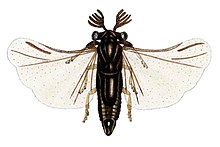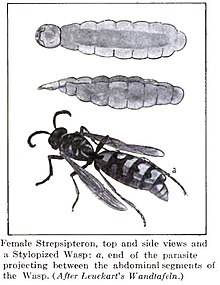
Back ملتويات الأجنحة Arabic ملتويات الاجنحه ARZ Strepsiptera AST Yelpikqanadlılar Azerbaijani Елпәҙә ҡанатлылар Bashkir Вееракрылыя Byelorussian Ветрилокрили Bulgarian Estrepsípters Catalan Strepsiptera CEB Řásnokřídlí Czech
| Strepsiptera Temporal range: Middle Cretaceous - recent
| |
|---|---|

| |
| Male | |

| |
| Stylopid female | |
| Scientific classification | |
| Domain: | Eukaryota |
| Kingdom: | Animalia |
| Phylum: | Arthropoda |
| Class: | Insecta |
| Clade: | Holometabola |
| Clade: | Aparaglossata |
| Clade: | Neuropteroidea |
| Clade: | Coleopterida |
| Order: | Strepsiptera Kirby, 1813 |
| Families | |
The Strepsiptera (/strɛpˈsɪptərə/) are an order of insects with eleven extant families that include about 600 described species. They are endoparasites of other insects, such as bees, wasps, leafhoppers, silverfish, and cockroaches. Females of most species never emerge from the host after entering its body, finally dying inside it. The early-stage larvae do emerge because they must find an unoccupied living host, and the short-lived males must emerge to seek a receptive female in her host.[1] They are believed to be most closely related to beetles, from which they diverged 300–350 million years ago, but do not appear in the fossil record until the mid-Cretaceous around 100 million years ago.[2]
The order is not well known to non-specialists, and the nearest they have to a common name is stylops, in reference to the genus Stylops.[3] The name of the order translates to "twisted wing", giving rise to other common names used for the order, twisted-wing insects and twisted-winged parasites.[4]
Adult males are rarely observed, although specimens may be lured using cages containing virgin females. Nocturnal specimens can also be collected at light traps.[1]
- ^ a b Whiting, M. F (2003). "Strepsiptera". In Resh, V. H.; R. T. Cardé (eds.). Encyclopedia of Insects. Academic Press. pp. 1094–1096.
- ^ Pohl, Hans; Wipfler, Benjamin; Boudinot, Brendon; Beutel, Rolf Georg (2020). "On the value of Burmese amber for understanding insect evolution: Insights from †Heterobathmilla – an exceptional stem group genus of Strepsiptera (Insecta)". Cladistics. 37 (2): 211–229. doi:10.1111/cla.12433. ISSN 1096-0031. PMID 34478185.
- ^ Merriam-Webster: stylops broadly: an insect of the order Strepsiptera |[1]
- ^ Pierce, W. Dwight (1909). A monographic revision of the twisted winged insects comprising the order Strepsiptera Kirby. Washington: US Government.